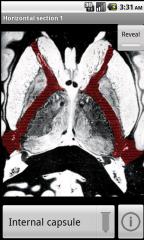علِّق
NeuroSlice
عندما يأتي خبراء من جامعة أكسفورد مع قرنائهم من أدنبره، لينتجوا تطبيقاً على أندرويد، فالأمر بالطبع مثير للإهتمام. البرنامج عبارة عن أطلس تشريحي شعاعي، و هو مقسم على قسمين، تشريح عياني، يظهر مناطق الدماغ المختلف و الأنوية العصبية Neuronulcei المختلفة، و القسم الشعاعي، و هو يظهر نفس الشرائح على صورة المرنان MRI، بحيث يتمكن المرء من فهم التشريح العصبي الشعاعي Radiological neuroanatomy.
بالطبع، الشرائح بمختلف المقاطع plane موجودة. الأمر حقاً جميل. لا يقتصر الأمر على عرض المقاطع، إنما يمكن البحث عن البنى structures نفسها و عرضها بمختلف المقاطع، بدلاً من عرض البنى الموجودة في مقطع واحد.
تصميم متقن و محتوى مفيد. للمهتمين بالتشريع و الأشعة: هو بالتأكيد ضروري.
Interactive neuroanatomy app
Learn your neuroanatomy using interactive mapped images. Each slice has neuroanatomical regions mapped out so that you can familiarise yourself with nuclei and tracts of the brain and spinal cord. I hope that NeuroSlice will be useful to training neurologists, neurosurgeons, medical students, and neuroscience students.
This is the very first release; if you have any problems with this app, please email me and I'll try and fix it in the update!
Neuroscan comprises 40 images taken from MRI scans and stained brain sections, which have been digitally labeled with the anatomical regions. They are all downloaded in the 6MB so you can browse offline.
The program allows you to
1) touch a region to highlight it, and its name will be displayed
2) select the name of a region, and the region will be highlighted
3) search the database of regions to show which slices a given locus is visible.
Most regions also have a short description, explaining the significance of the region. and can link out to Wikipedia if you have an internet connection.
Finally, there is a testing-mode (beta) in which you can test yourself in one of two ways. Either you have to touch the region whose name is shown, or you have to select the name of the region which is highlighted.
The software is written by Sanjay Manohar ( http://www.smanohar.com ) who also wrote the HOM physiology simulator in collaboration with Roger Carpenter (http://www.homphysiology.org).
To contact the author, email me on homphysiology@gmail.com.
Want to know more?
-----------------------------
This app has been developed to support the fifth edition of Neurophysiology: A conceptual approach, 5E by Roger Carpenter and Benjamin Reddi - an unrivalled ‘one stop shop’ for students of medicine, physiology and applied physiology, neurophysiology, neuroscience and other bioscience courses looking for a comprehensive, integrated introduction to the challenging disciplines of neuroscience and neurology. Click here to buy: http://www.crcpress.com/product/isbn/9781444135176
Purchasers of Neurophysiology: A conceptual approach, 5E also get free access to a companion website: http://cw.tandf.co.uk/neurophysiology/ -- which provides further interactive resources to support teaching and learning:
• NeuroLab – interactive exhibits;
• NeuroSound – sound clips illustrating the chapter on the auditory system;
• NeuroVid – a comprehensive set of movie clips showing the components of a standard clinical neurological examination; and
• NeuroQuestions – sixteen sets of interactive MCQs.
Credits
The app was developed by Dr Sanjay Manohar of Oxford University. The material for NeuroScan and NeuroSlice was put together by Alice Miller of Edinburgh University Medical School, and the Java programs for desktop were written by Sanjay Manohar and Robin Marlow.
The histological material was taken, with permission, from Riley HA, An Atlas of the Basal Ganglia, Brain Stem and Spinal Cord, 1943, Williams and Wilkins, Baltimore, and the MRI scans are taken from Gillespie JE and Jackson A (eds), MRI and CT of the Brain, 2000, Hodder Arnold, London, by kind permission.
Much of the development of this material was supported by an award to RHSC from the Institute for Learning and Teaching.




